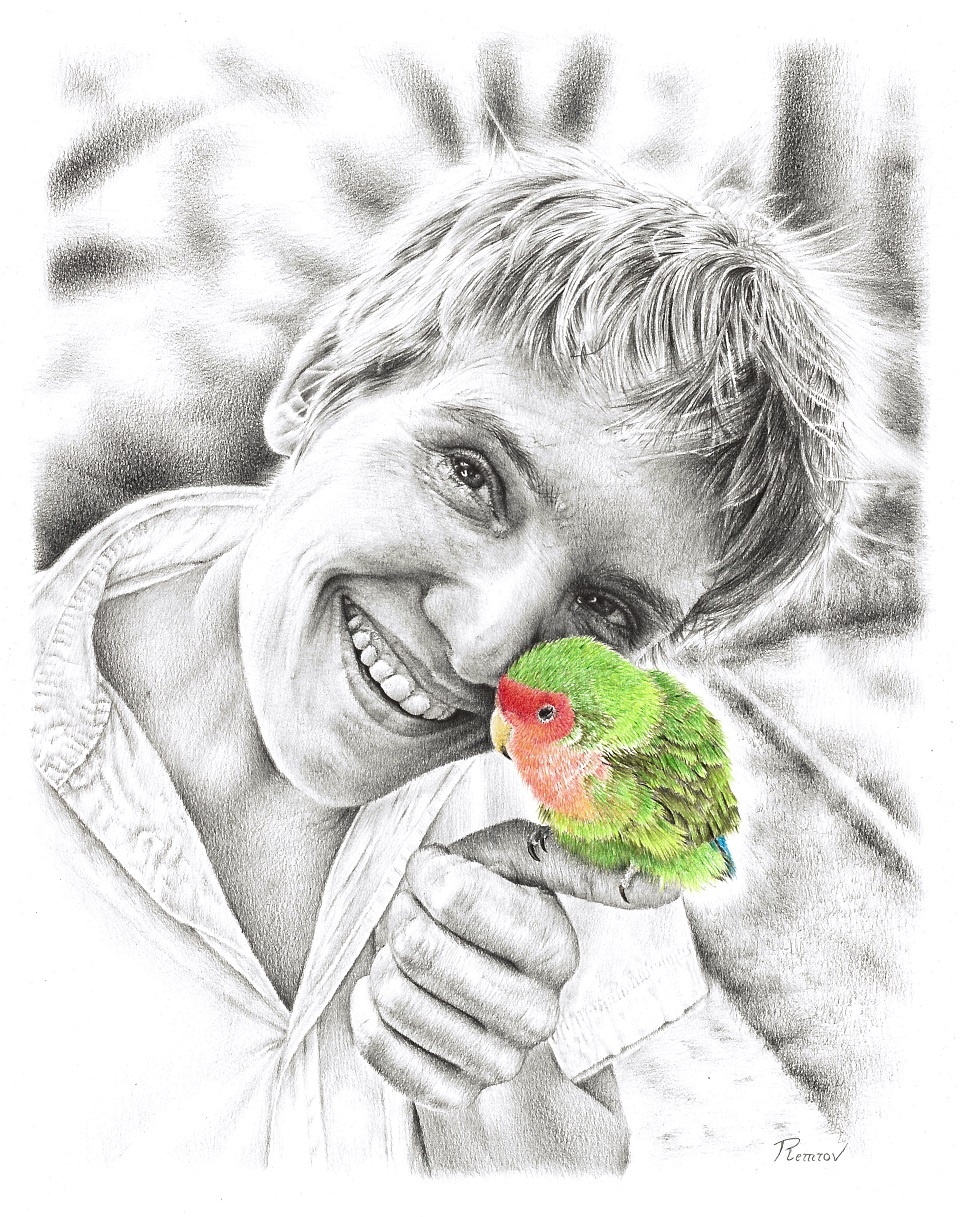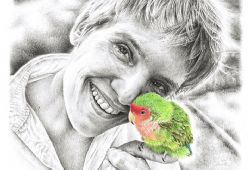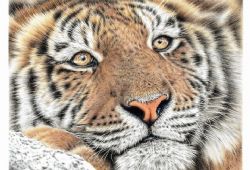Autism exists on such a large spectrum
that we often have trouble understanding and identifying it. In most cases,
doctors will classify autism as a neurobehavioral condition that compromises
social interactions, behavioural norms and language learning.
Because of the
stigma surrounding the disorder, we may often assume individuals who live with
autism cannot succeed independently. Perhaps we assume that for many people, the
obstacles brought fourth by autism are too difficult to overcome. Then someone
like Casey ďRemrovĒ Vormer comes along.
Born in the Netherlands, Vormer, who
works under the name, ďRemrovĒ, has been making a splash in the Montreal art
scene. About eight years ago, Remrov began producing photorealistic portraits
using only colour pencils. He began showing these works at exhibits and has
helped support himself with the sales. When glancing through an art gallery, one
of his drawings catches your attention immediately. The realism in his work is
incredible. Take his portrait of a lion for example. The texture of the fur as
well as the lifelike expression on the creatureís face makes viewers feel as if
they are looking at a photograph.
Most people would
assume the artist has spent years of rigorous training at a fine arts academy,
but Remrov is completely self-taught. He
says his method is a little unconventional. ďWhen Iím working on a drawing, I
donít try to draw fur or whiskers. For example, I draw the details I see, one
by one,Ē he explains. The artist attributes his workís realistic elements to
his close attention to detail. ďI see my whole world in detail because of
autism. It helps me see all the small things in a picture. But I am also a perfectionist,
so Iím often not satisfied with my own work,Ē Remrov says.
ďI was drawing as
soon as I was old enough to hold a pencil. I would draw everything. Originally
it was road maps when I was very little. I loved the patterns and colours,Ē Remrov
explains. Just about any piece in a Remrov
exhibit is magnificent but it is his portraits of animals that especially stand
out. It is no coincidence that animals are in fact his favourite thing to draw.
He says his initial inspiration for these photorealistic pieces came from fellow
artist, Richard Symonds. Like Remrov, Symonds is an animal lover.
Remrov isnít
alone. There are many other talented and successful people who are also on the autism
spectrum. People like Susan Boyle, comedian Dan Aykroyd and Colorado State
University Professor, Temple Grandin, just to name a few. Autism representation
in the media is also on the rise with shows like ABCís The Good Doctor. But almost all of these examples show us the high
functioning end of the spectrum. And while in many cases, autism can act like a
superpower, there are often many struggles that come with it. Despite his
incredible artistic talents, Remrov still struggles with social interactions. ďSocial
situations are still a challenge. Being autistic affects that part of my life
quite a lot. Making friends has always been difficult because whatís natural
for others is not automatic for autistic people. People can be very
unpredictable which makes socializing confusing. For us, non-verbal
communication and facial expressions are especially hard to understand,Ē Remrov
explains.
Remrov also says
there were some difficulties that came along with being diagnosed with autism
as an adult. ďI was diagnosed fairly late. I was 21. I had always had difficulties
with speech and language. I also had trouble making friends and socializing. My
family and I always wondered what was going on. It [being diagnosed] just felt
like a lot of puzzle pieces fell into place and it explained a lot of the
struggles I had growing up.Ē
April 2, 2019 is
World Autism Awareness Day. It is a day designed to encourage conversation about
people with Autism Spectrum Disorder (ASD). Remrov agrees this day should be
recognized and celebrated. ďPeople should acknowledge our difficulties but
understand that we also have many strengths. Many people donít realize that Ďneurotypicalsí
and autistic people make great teams.Ē
Despite all the challenges he faces, Remrov
continues to grow as a person and thrive as an artist. He does not feel like a
victim. He has instead taken what others might deem to be a setback and has
turned it into something beautiful.

 In The Latest Issue:Latest Issue:
In The Latest Issue:Latest Issue:
- A Bittersweet Farewell
- The new Laval Aquatic Co...
- The End of an Era:
Articles
Calendar
Virtual- ANNUAL TEACHER APPRECIATION CONTEST
- APPUI LAVAL
- ARTS & CULTURE
- CAMPS
- CAR GUIDE
- CCIL
- CENTENNIAL ACADEMY
- CHARITY FUNDRAISING
- CITYTV
- COSMOD‘ME
- COMMUNITY CONNECTIONS
- COVER STORY
- DINA DIMITRATOS
- …COLE SUP…RIEURE DE BALLET DU QU…BEC
- EDITORIALS
- …DUCALOI
- EDUCATION
- EMPLOYMENT & ENTREPRENEURSHIP
- F TE DE LA FAMILLE
- F TE DU QUARTIER SAINT-BRUNO
- FAMILIES
- FESTIVAL LAVAL LAUGHS
- F TE DE QUARTIER VAL-DES-BRISES
- FINANCES
- GLI CUMBARE
- GROUPE RENO-EXPERT
- HEALTH & WELL-BEING
- 30 MINUTE HIT
- ANXIETY
- CHILDREN`S HEALTH & WELLNESS
- CLOSE AID
- DENTAL WELLNESS
- EXTREME EVOLUTION SPORTS CENTRE
- FONDATION CIT… DE LA SANT…
- GENERAL
- HEARING HEALTH
- MESSAGES FROM THE HEALTH AGENCY OF CANADA
- MENTAL HEALTH
- SEXUALITY
- SOCIAL INTEGRATION
- SPECIAL NEEDS
- TEENS
- THE NUTRITION CORNER
- THE NUTRITION CORNER - RECIPES
- VACATION DESTINATION
- WOMEN'S FITNESS
- WOMEN'S HEALTH
- HILTON MONTREAL/LAVAL
- HOME & GARDEN
- INTERNATIONAL WOMEN'S DAY
- JAGUAR LAVAL
- LAVAL ņ V…LO
- LAVAL FAMILIES TV SHOW
- LAVAL FAMILIES MAGAZINE CARES
- LAVAL URBAN IN NATURE
- LE PARCOURS DES H…ROS
- LES PETITS GOURMETS DANS MA COUR
- LEON'S FURNITURE
- LEONARDO DA VINCI CENTRE
- LFM PREMIERES
- LIFE BALANCE
- M.P. PROFILE
- MISS EDGAR'S AND MISS CRAMP'S SCHOOL
- MISSING CHILDREN'S NETWORK
- NETFOLIE
- NORTH STAR ACADEMY LAVAL
- OUTFRONT MEDIA
- PASSION SOCCER
- PARC DE LA RIVI»RE-DES-MILLE-őLES
- P¬TISSERIE ST-MARTIN
- PIZZERIA LŐOLņ
- PLACE BELL
- PORTRAITS OF YOUR MNA'S
- ROCKET DE LAVAL
- SACRED HEART SCHOOL
- SCOTIA BANK
- SHERATON LAVAL HOTEL
- SOCI…T… ALZHEIMER LAVAL
- STATION 55
- STL
- SUBARU DE LAVAL
- TECHNOLOGY
- TEDXLAVAL
- TODAY`S LAURENTIANS AND LANAUDI»RE
- TODAY`S LAVAL
- WARNER MUSIC
- THIS ISSUE
- MOST RECENT
Magazine
Remrovís Story: Turning Autism into an Artistic Tool
Articles ~e 105,7 Rythme FM 4 chemins Annual Teacher Appreciation Contest Appui Laval Arts & Culture Ballet Eddy Toussaint Camps THIS ISSUE MORE...
CONTESTS Enter our contests
CONTESTS Enter our contests
CALENDAR
Events & Activities
COMMUNITY Posts Events
PUBLICATIONS Our Magazine Family Resource Directory
LFM BUSINESS NETWORK Learn more
COUPONS Click to save!
COMMUNITY Posts Events
PUBLICATIONS Our Magazine Family Resource Directory
LFM BUSINESS NETWORK Learn more
COUPONS Click to save!
SUBSCRIPTIONS
Subscribe to the magazine
Un-Subscribe
E-NEWSLETTER Subscribe to our E-newsletter Un-Subscribe
WRITE FOR US Guidelines & Submissions
POLLS Vote today!
E-NEWSLETTER Subscribe to our E-newsletter Un-Subscribe
WRITE FOR US Guidelines & Submissions
POLLS Vote today!
ADVERTISERS
How to & Media guide
Pay your LFM invoice
SUGGESTIONS Reader's Survey Suggest a Listing
LFM About Us Our Mission Giving Back Contact Us
SUGGESTIONS Reader's Survey Suggest a Listing
LFM About Us Our Mission Giving Back Contact Us
 PICK-UP LOCATIONS
Get a copy of LFM!
PICK-UP LOCATIONS
Get a copy of LFM!
TERMS & CONDITIONS Privacy | Terms
ISSN (ONLINE) 2291-1677
ISSN (PRINT) 2291-1677
Website by ZENxDESIGN





 BY:
BY: 
Tweet
Share